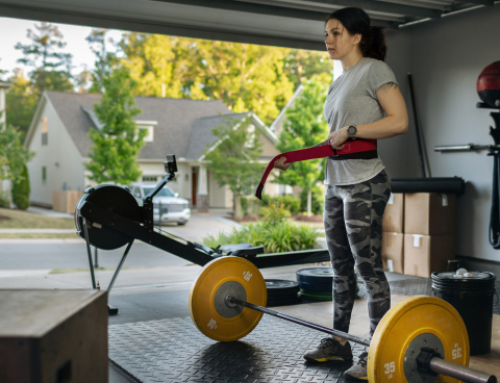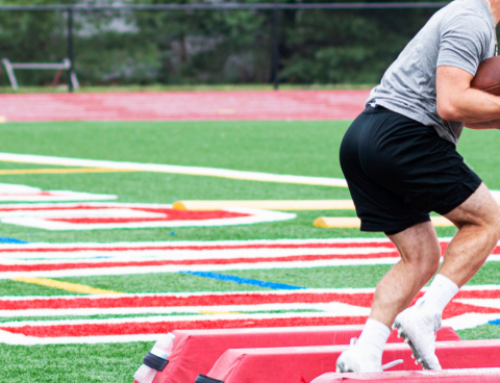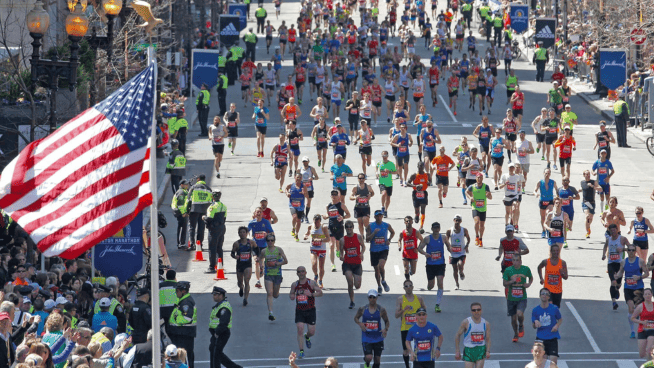Sprint Technique Review: Part 1-Forefoot Dominance
Speed is found on the balls of your feet
This key technique calls for a majority of our body weight to be concentrated over the front of our foot. The more forward our weight is over our feet, the more forefoot dominant we are, and vice versa. This technique encourages “leaning” while sprinting, but make sure you are not breaking at the hip. This concept becomes important in sprinting for a few reasons.
First, in sprinting we are trying to move in a forward direction. If we simply shift our weight forward on our feet, we are already that much closer to where we want to go and it is easier to move in this direction. So our efficiency automatically improves with our body weight forward. Just stand up straight, lean, and fall forward (Rolling start) and you’ll see what I mean.
Secondly, running on our forefoot or toes is a much healthier and more effective way to run faster. Kelly Baggett was I believe the very first to classify Forefoot Dominance in sprinting as moving from the hip, while Rearfoot Dominance in sprinting as knee running. Running from the toes activates the hips, still activates the knees, and brings these two body parts together more equally. While heel running overloads the knees and inhibits the activity of the hip.
Let’s look at the research
Running on the heel creates greater impacts, increases braking forces, weakens the calves since the heel is supported on the ground, stresses and potentially hyperextends the knees much more, applies some force in the wrong direction, creates over-striding, creates longer GCT (Ground Contact Time), creates more energy loss, and will slow us down.
Does that sound like a recipe for success to you? Fortunately, a slight adjustment of Forefoot Dominance will cure all of these aforementioned issues and increase your speed potential in the process. In 1983, a researcher by the name of Kerr found and reported that runners who were faster in short, medium, and long-distance events were FF dominant. 81
More Research to Support Forefoot Sprinting
What else was interesting is that only 2 percent of participants exhibited this technique. Also please note that these studies are infrequent and utilized with long-distance runners who are much slower, so the findings are expected.
Like in the case of the famous study from Hasegawa in 2007. 2 This was a Japanese study that examined much slower marathon runners who were rearfoot dominant. What was interesting, though, is that a higher percentage of faster runners ran on their midfoot. I’m sure that if they were examined at high speeds like in the case of sprinters, the results would indicate that forefoot dominance was even more prevalent.
The study also mentioned that a continuum in technique was present. As runners decreased speed, rearfoot running was more prevalent and vice versa. I’m certain after watching hundreds of athletes run over the years that if more studies were conducted on the matter, a constant finding from researchers would be that fast sprinters are forefoot dominant.
Positive versus Negative Foot Speed
Premature grounding of the swing leg typically means that the foot will still be moving forward concerning the body when ground contact is made. This is referred to as excessive positive foot speed and it is potentially disruptive to efficient sprinting.
Positive foot speed is associated with over-striding or having our foot too far out in front of our mass. Ideally, the foot should be moving backward concerning the body when a touchdown occurs. This is often referred to as negative foot speed at ground contact, and this movement pattern is highly correlated with increased sprinting speed. Negative foot speed is also associated with forefoot running. 3
SCIENTIFIC REFERENCES
#1-Kerr, B. A., Beauchamp, L., Fisher, V. & Neil, R. Footstrike Patterns in Distance Running. Biomechanical aspects of sports shoes and playing surfaces:135–142,1983.
#2-Hasegawa H, Yamauchi T, and Kraemer WJ. Journal of Strength and Conditioning Research 21: 888-893, 2007.
#3-Mann, R. The Mechanics of Sprinting. CompuSport: Primm, NV. 2005.
RECOMMENDED FOR YOU
MOST POPULAR
Sprint Technique Review: Part 1-Forefoot Dominance
Speed is found on the balls of your feet
This key technique calls for a majority of our body weight to be concentrated over the front of our foot. The more forward our weight is over our feet, the more forefoot dominant we are, and vice versa. This technique encourages “leaning” while sprinting, but make sure you are not breaking at the hip. This concept becomes important in sprinting for a few reasons.
First, in sprinting we are trying to move in a forward direction. If we simply shift our weight forward on our feet, we are already that much closer to where we want to go and it is easier to move in this direction. So our efficiency automatically improves with our body weight forward. Just stand up straight, lean, and fall forward (Rolling start) and you’ll see what I mean.
Secondly, running on our forefoot or toes is a much healthier and more effective way to run faster. Kelly Baggett was I believe the very first to classify Forefoot Dominance in sprinting as moving from the hip, while Rearfoot Dominance in sprinting as knee running. Running from the toes activates the hips, still activates the knees, and brings these two body parts together more equally. While heel running overloads the knees and inhibits the activity of the hip.
Let’s look at the research
Running on the heel creates greater impacts, increases braking forces, weakens the calves since the heel is supported on the ground, stresses and potentially hyperextends the knees much more, applies some force in the wrong direction, creates over-striding, creates longer GCT (Ground Contact Time), creates more energy loss, and will slow us down.
Does that sound like a recipe for success to you? Fortunately, a slight adjustment of Forefoot Dominance will cure all of these aforementioned issues and increase your speed potential in the process. In 1983, a researcher by the name of Kerr found and reported that runners who were faster in short, medium, and long-distance events were FF dominant. 81
More Research to Support Forefoot Sprinting
What else was interesting is that only 2 percent of participants exhibited this technique. Also please note that these studies are infrequent and utilized with long-distance runners who are much slower, so the findings are expected.
Like in the case of the famous study from Hasegawa in 2007. 2 This was a Japanese study that examined much slower marathon runners who were rearfoot dominant. What was interesting, though, is that a higher percentage of faster runners ran on their midfoot. I’m sure that if they were examined at high speeds like in the case of sprinters, the results would indicate that forefoot dominance was even more prevalent.
The study also mentioned that a continuum in technique was present. As runners decreased speed, rearfoot running was more prevalent and vice versa. I’m certain after watching hundreds of athletes run over the years that if more studies were conducted on the matter, a constant finding from researchers would be that fast sprinters are forefoot dominant.
Positive versus Negative Foot Speed
Premature grounding of the swing leg typically means that the foot will still be moving forward concerning the body when ground contact is made. This is referred to as excessive positive foot speed and it is potentially disruptive to efficient sprinting.
Positive foot speed is associated with over-striding or having our foot too far out in front of our mass. Ideally, the foot should be moving backward concerning the body when a touchdown occurs. This is often referred to as negative foot speed at ground contact, and this movement pattern is highly correlated with increased sprinting speed. Negative foot speed is also associated with forefoot running. 3
SCIENTIFIC REFERENCES
#1-Kerr, B. A., Beauchamp, L., Fisher, V. & Neil, R. Footstrike Patterns in Distance Running. Biomechanical aspects of sports shoes and playing surfaces:135–142,1983.
#2-Hasegawa H, Yamauchi T, and Kraemer WJ. Journal of Strength and Conditioning Research 21: 888-893, 2007.
#3-Mann, R. The Mechanics of Sprinting. CompuSport: Primm, NV. 2005.












